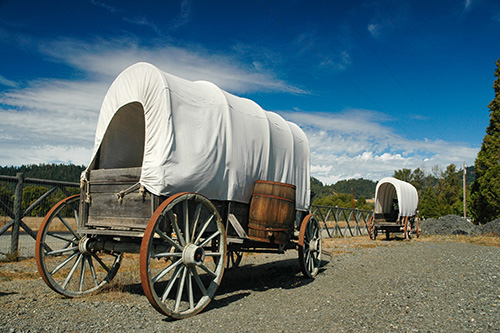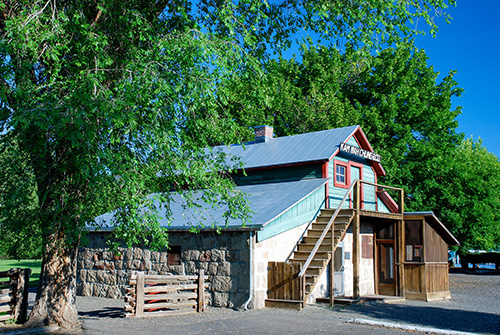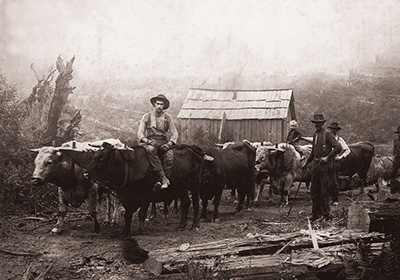
The Applegate Trail blazed a new route to the Willamette Valley. Above, covered wagons greet visitors to the Applegate Wagon Trail Interpretive Center in Sunny Valley. (Oregon Scenic Images collection)
The Applegate Trail blazed a new route to the Willamette Valley. Above, covered wagons greet visitors to the Applegate Wagon Trail Interpretive Center in Sunny Valley. (Oregon Scenic Images collection) In the 1840s and 1850s, that agricultural paradise centered on the Willamette Valley, where the landscape most easily accommodated the immigrants’ efforts to create market-oriented, subsistence-based family farms. But even before Oregon joined the United States in 1859, new challenges and opportunities drew recent arrivals out into Oregon’s diverse environments. One challenge was finding land: thanks to the generous provisions of the Donation Land Law, early White immigrants had gobbled up most of the good free land in the Willamette Valley, so new immigrants either paid premiums for a farm there or were pushed out to unclaimed, less-ideal land elsewhere. New opportunities in Oregon’s environments also pulled immigrants to other parts of the state. Discoveries of gold drew not only prospectors hoping for a quick strike, but also miners, traders and settlers who tried to turn temporary gold boom towns into permanent settlements. As American settlers and the federal government increased their pressure on Native peoples, especially after the Civil War, more land opened up in different parts of the state for different kinds of work, including ranching and logging. No matter where they went or how they tried to make a living, these Oregonians, like those who settled in the Willamette Valley, brought with them both anxiety about the environments they confronted and a desire to turn those challenges into opportunities.
Southwest Oregon
Even before the Willamette Valley filled up, some American settlers headed to southwestern Oregon to farm or find faster ways to profit off the land. In 1846, a party led by Jesse and Lindsay Applegate blazed a new trail to the Willamette Valley that passed through southern Oregon, and a few years later, the Applegate party families moved south and settled in the Umpqua River Valley. Other farmers followed them there and later moved into other river valleys in southwestern Oregon, including the Rogue River area. Miners and traders soon joined them, first on their way to and from the gold fields of California, and then to make their own claims after the discovery of gold in the Rogue River Valley in 1851. Prospectors spread throughout southwestern Oregon, sifting, digging and blasting for gold from the broad coastal beaches to the smallest tributaries of the Rogue and Umpqua rivers. Many of the miners stayed after the boom years, establishing their own small farmsteads or continuing to squeeze ever-smaller amounts of gold out the streams and hillsides. Among these miners were Chinese migrants, who worked creeks and streams throughout southwest Oregon, ran merchant businesses, and established communities, such as Jacksonville’s Chinatown. Southwestern Oregon landscapes also offered another source of riches: ancient forests full of timber, ready to be cut, processed and shipped off to California markets. By 1870, the lure of timber, gold and soil had drawn 15% of Oregon’s population to southwestern Oregon.
Eastern Oregon
 The Kam Wah Chung state historic site in John Day. The building served as a cultural center for Chinese miners in eastern Oregon. (Oregon Scenic Images collection)
The Kam Wah Chung state historic site in John Day. The building served as a cultural center for Chinese miners in eastern Oregon. (Oregon Scenic Images collection) American immigrants initially avoided eastern Oregon, where the climate and landscape challenged their agricultural pursuits. But gold, free land and ranching opportunities soon pulled American speculators and settlers east of the Cascades. Methodist missionaries established a station at The Dalles in 1838, and soon emigrants on the Oregon Trail were stopping there to rest before continuing on to the Willamette Valley, occasionally by way of the Barlow Road around Mount Hood. Some American settlers stayed in The Dalles, and the town developed into a small but important trading link between the west and east sides of the Cascades, much as it had been for the Native peoples of the Columbia Plateau and western valleys. The White population of eastern Oregon remained very small—only 3% of the state’s Whites lived there in 1860—until the discovery of gold in 1861 in the John Day and Powder River valleys. As in southwestern Oregon, thousands of prospectors followed the rumors of gold, scouring the hillsides and streambeds and establishing dozens of short-lived mining towns. The rush also contributed to the economic growth of The Dalles, Umatilla Landing, La Grande and other trading and shipping sites on the Columbia River and the surrounding valleys. That growth was shaped by a growing Chinese population of miners, merchants, physicians and more, who built thriving communities in John Day, The Dalles, Baker City and elsewhere in northeastern Oregon.
To serve the appetites of those miners and communities, another form of resource extraction developed: raising and grazing cattle and sheep, which thrived on the semi-arid lands east of the Cascades. Recent Willamette Valley settlers and their children looking for open lands and new economic opportunities led these initial ranching efforts, which continued even after the gold booms went bust. In a few pockets in eastern Oregon, including Harney Basin, some subsistence farming families established homesteads and adapted their agricultural practices to the higher altitude and drier climate. But the landscapes east of the Cascades presented a few too many challenges to White settlers, and the area remained sparsely populated, with just 14% of the state’s White population in 1870.
 An oxen team used for logging in Coos County. (Courtesy of Coos County History Museum)
An oxen team used for logging in Coos County. (Courtesy of Coos County History Museum) As White settlers spread throughout the state, they redefined, remade, and, to some degree, overcame Oregon’s environments. Americans drew the territory and state of Oregon with straight eastern and southern boundaries that recognized political interests rather than ecological reality. As they claimed land through the Donation Land Law and successive legislation, White settlers imprinted on the landscape a peculiar patchwork of square and rectangular homesteads. Farmers eliminated some predators and raised imported plants and livestock that pushed out existing flora and fauna. Miners rearranged streams and dug into hillsides, loggers cut down trees and ranchers grazed cattle and sheep on native grasslands. Despite such changes, the new Oregonians recognized some limits to their efforts to overcome nature. They relied on manual and animal labor and used relatively simple tools, limiting the extent and intensity of ecological transformations. They depended on and remained vulnerable to seasonal cycles, hoping for enough rain to grow crops, but not so much as to flood them out of home and farm. Even political boundaries and land claims bent to the realities of nature: the Pacific Ocean and Columbia River bounded the state to the west and north, and environmental obstacles, such as rivers and mountains, often defined the practical limits of where farmers could plant crops. In short, the first generation of new Oregonians accepted the power of nature. Many of their children would have a different view of their relationship to Oregon’s environments.
Next:
Section II: Connecting Oregon >